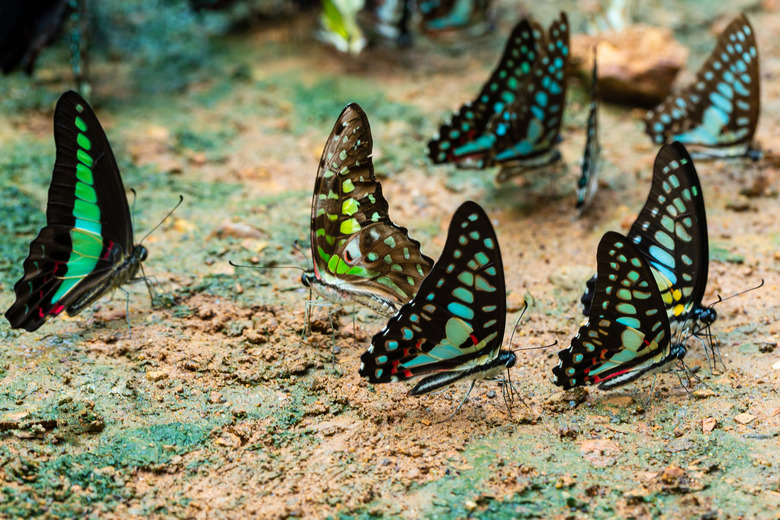What Are The Structural Adaptations Of A Butterfly?
The survival of any creature depends on its ability to satisfy its requirements for things like food and shelter while avoiding predators and other harms. Adaptations, either in the animal's behavior or in its structure, give the animal the features it needs to thrive in its environment.
While butterflies do display behavioral adaptations, such as the monarch butterfly's instinct to migrate long distances, their body forms, or structural adaptations, are equally helpful.
Butterfly Adaptations: Camouflage
Butterfly Adaptations: Camouflage
Butterflies survive long enough to reproduce by avoiding the many predators that feed on them, such as birds, amphibians, reptiles and mammals. One of the butterfly's adaptations for predator avoidance is to have the same color or pattern as its surroundings, making it difficult to see.
When the wings of the question mark butterfly (Polygonia interrogationis) are open, its bright orange color makes it highly visible. But when its wings are closed and folded up over its body, the jagged edges and brown and gray coloring make it look like a dried leaf. This camouflage protects the butterfly by allowing it to blend in with the forest floor.
Since they don't have wings for a quick escape, many butterfly larvae (caterpillars) depend on camouflage for survival. Often, caterpillars are green, allowing them to blend in with the leaves on which they feed.
The resting stage of a butterfly before it becomes a winged adult is called the pupa (chrysalis). Since it cannot move, it needs protection from predators while it is transforming. The pupa of the giant swallowtail butterfly (Papilio cresphontes Cramer) is colored and patterned to look like the stick or branch where it hangs.
Disguise
Disguise
If the butterfly isn't blending in with its environment, there are other structural butterfly adaptations that help it avoid harm. Resembling something else, like bird droppings or the face of an owl, can either deter or scare away potential predators. In both caterpillars and adult butterflies, depending on the species, there are many examples of disguises.
The caterpillar of the giant swallowtail butterfly looks like bird droppings with its white and dark coloring. Because it resembles something unpleasant, animals will likely avoid eating it. Other caterpillars such as the spicebush swallowtail (Papilio troilus), can look like the head of a snake and scare off harmful animals.
Adult butterflies have also developed structural adaptations that disguise themselves. The blue morpho is a butterfly with "eyes" on its wings. When open, the wings are an iridescent blue color. If the blue morpho folds up its wings, however, it can startle potential predators with the large eyespot pattern (called ocelli) on the underside of the wings.
Warning
Warning
Butterfly adaptations that deter predators don't always involve hiding or pretending to be something else. Sometimes butterflies are the complete opposite of camouflaged. They advertise themselves, a phenomenon known as aposematism. Just like the bright yellow and black stripes of wasps and bees warn of a dangerous sting, the bright colors of butterflies can warn as well.
The monarch butterfly (Danaus plexippus) diet consists mainly of poisonous milkweed. This diet makes the butterfly itself poisonous. Its bright orange color and contrasting black pattern warn birds and others to avoid it.
Mimicry
Mimicry
Some butterflies take advantage of others with warning coloration. This is known as Batesian mimicry. Viceroy butterflies (Limenitis archippus) are not poisonous but have evolved similar wing colors and patterns to mimic those of the monarch.
Birds learn to avoid monarchs after tasting one and getting sick. By resembling the monarch, viceroy butterflies also avoid being eaten by those birds.
References
- Bio Web of Conferences: Mimicry in Heliconius and Ithomiini Butterflies
- University of Wisconsin Milwaukee: Anglewings (Family Nymphalidae)
- University of Kentucky College of Agriculture, Food and Environment: All About Butterflies
- University of Florida IFAS: Featured Creatures: Giant Swallowtail
- American Museum of Natural History: Warning: Aposematism Explained
- The Guardian: GrrlScientist: Birth of the Blue Morphos
Cite This Article
MLA
Godawa, Jean. "What Are The Structural Adaptations Of A Butterfly?" sciencing.com, https://www.sciencing.com/structural-adaptations-butterfly-8305508/. 22 November 2019.
APA
Godawa, Jean. (2019, November 22). What Are The Structural Adaptations Of A Butterfly?. sciencing.com. Retrieved from https://www.sciencing.com/structural-adaptations-butterfly-8305508/
Chicago
Godawa, Jean. What Are The Structural Adaptations Of A Butterfly? last modified March 24, 2022. https://www.sciencing.com/structural-adaptations-butterfly-8305508/
